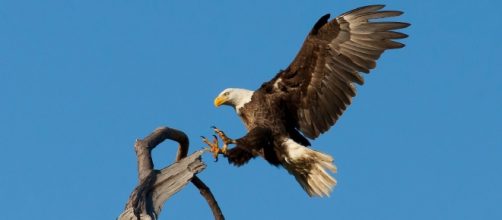Greens are blaming President Donald Trump for overturning a rule prohibiting the use of lead bullets on national wildlife reserves that some biologists blame for eagle deaths. But before he left office, President Obama issued 30-year permits allowing the wind industry to legally kill thousands of eagles without penalty. Yet 30 doctors and scientists sent Interior Secretary Ryan Zinke decrying the use of lead bullets, not wind energy.
The Guardian cites a 2014 study estimating 750 eagles killed over 30 years had died from poisoning, many eating lead bullet fragments inside carrion.
That’s 25 birds a year. Compare that to Obama’s revised permitting rule, which makes it legal for wind farms to “unintentionally” kill up to 4,200 eagles a year without fear of penalty or prison.
U.S. Fish and Wildlife Service (USFWS) managers said the mounting number of wind farms popping up near their habitats has led to thousands of these raptors getting chopped to pieces. That’s 126,000 deaths over 30 years compared to poisoning by lead, which estimated only 750 were killed. That’s 168 times more eagle deaths than those from lead bullets. The “eagle take” permit essentially tells the wind industry that eagles are akin to hunted animals.
— JC (@worldgoneweird) December 14, 2016
Death by green energy
As previously reported, the USFWS said the current population of the iconic bird could withstand 2,000 deaths a year from wind blade deaths.
The USFWS said 545 golden eagles are maimed or killed from collisions with giant wind turbines based on what they have found littered around wind farms. That number doesn’t include injured birds that fly off and die somewhere else. Or birds attracted to and then vaporized by solar panels.
The typical hunting bullet has a lead core inside a metal jacket alloy composed of about 90 percent copper and five to 10 percent zinc. Lead is used for the core because it is heavy, cheaper than copper and steel, very stable, and easy to mold. Because its weight to volume is so high, a small lead bullet can strike an impressive blow when used by a rifle or firearm, making it the preferred choice for hunting larger game.
Feds to Allow Even More Bald Eagles Killed or Maimed for Clean Energy https://t.co/fPpg449hZt pic.twitter.com/HOg1QQvHGH
— Indian Country Today (@indiancountry) June 8, 2016
In 2007, the iconic bird was removed from the Endangered and Threatened Wildlife list, but the spate of new wind farms is causing their numbers to drop. One group opposed to Obama’s decades-long permitting standard is the National Audubon Society, who believe it is too long given all the unknowns of the relatively new technology. The Audubon Society supports renewables, just not at the expense of an animal brought back from the edge of annihilation.

